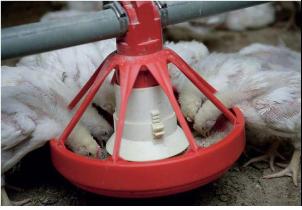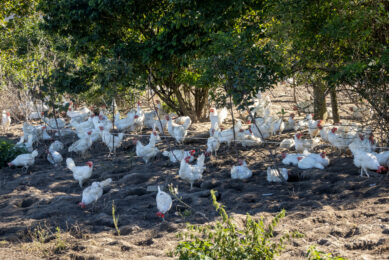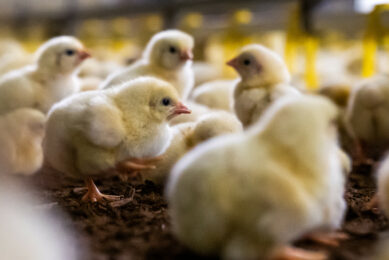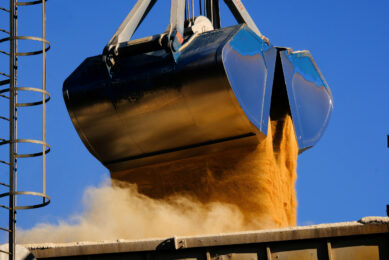Better pellet quality improves broiler performance

Researchers in New Zealand demonstrated that it is possible to manufacture high quality pellets at low conditioning temperature through the addition of a pellet binder and/or moisture to mash diets.
Feeding pelleted diets per se is not enough to ensure optimum performance of broilers. The quality of pellets must also be taken into account. While assessing the cost-effectiveness of investment in high pellet quality, consideration should also be given to whether or not the strategies employed to improve pellet quality may have a negative effect on nutrient availability. More specifically, conditions of high heat and moisture may induce non-favourable reactions that lead to reduced nutrient availability. A previous study in the lab of Massey University in Palmerston North, New Zealand has shown that, while steam-conditioning of mash diets at 60ºC improved growth response, increasing conditioning temperatures above 60ºC had negative effects on nutrient utilisation and performance of broiler starters. On the other hand, in pelleted diets, conditioning at 90ºC improved pellet quality and the better pellet quality resulted in the restoration of deteriorated performance.
Based on these results, the researchers evaluated possible ways of simultaneously maintaining high nutrient utilisation as well as achieving a reasonable pellet quality without using high conditioning temperatures.
Broiler trial
To check their hypothesis wheat-soy based broiler starter and finisher diets were formulated to meet the Ross 308 strain recommendations for major nutrients. The experimental treatments were as described in Table 1. Conditioning temperature was altered by adjusting the steam flow rate and measured at the outlet of the conditioner. Conditioning time of the mash was 30 seconds. The pellet binder and moisture were added as a top-dressing to the basal mash diet in a single-screw paddle mixer.
To check their hypothesis wheat-soy based broiler starter and finisher diets were formulated to meet the Ross 308 strain recommendations for major nutrients. The experimental treatments were as described in Table 1. Conditioning temperature was altered by adjusting the steam flow rate and measured at the outlet of the conditioner. Conditioning time of the mash was 30 seconds. The pellet binder and moisture were added as a top-dressing to the basal mash diet in a single-screw paddle mixer.
All diets were pelleted using a semi laboratory scale pellet mill (180 kg/h) and equipped with a die ring (3-mm hole and 35-mm thickness). Each of the six dietary treatments was offered ad libitum to six replicate cages (eight birds per cage). Cages were used to better derive performance data.
Pellet durability index (PDI) and pellet hardness were determined using a Holmen Pellet Tester and a Stable Micro Systems Texture Analyser, respectively. The cage means were used to derive performance data.
Pellet durability index (PDI) and pellet hardness were determined using a Holmen Pellet Tester and a Stable Micro Systems Texture Analyser, respectively. The cage means were used to derive performance data.
Trial results
During the starter period (d 1 to 21), birds fed diets conditioned at 60ºC, regardless of pellet binder or/and moisture addition, gained more weight than those fed diets conditioned at 90ºC with or without pellet binder (Table 2). Addition of pellet binder or/and moisture to the diets conditioned at 60ºC had no effect on weight gain, feed intake and feed per gain. Pellet binder addition to the diet conditioned at 90ºC increased weight gain and feed intake and improved feed per gain compared to the diet conditioned at 90ºC with no pellet binder. Birds fed the diet conditioned at 90ºC without pellet binder had similar feed per gain to those fed the diet conditioned at 60ºC without pellet binder or moisture addition, but higher than those fed other dietary treatments. Over the whole trial period (d 1 to 35, Table 2), birds fed the diet conditioned at 90ºC with no pellet binder addition (T5) had lower weight gains than those fed other dietary treatments. The dietary treatments had no effect on feed per gain.
During the starter period (d 1 to 21), birds fed diets conditioned at 60ºC, regardless of pellet binder or/and moisture addition, gained more weight than those fed diets conditioned at 90ºC with or without pellet binder (Table 2). Addition of pellet binder or/and moisture to the diets conditioned at 60ºC had no effect on weight gain, feed intake and feed per gain. Pellet binder addition to the diet conditioned at 90ºC increased weight gain and feed intake and improved feed per gain compared to the diet conditioned at 90ºC with no pellet binder. Birds fed the diet conditioned at 90ºC without pellet binder had similar feed per gain to those fed the diet conditioned at 60ºC without pellet binder or moisture addition, but higher than those fed other dietary treatments. Over the whole trial period (d 1 to 35, Table 2), birds fed the diet conditioned at 90ºC with no pellet binder addition (T5) had lower weight gains than those fed other dietary treatments. The dietary treatments had no effect on feed per gain.
High T, better PDI
In starter diets, pellet durability of the diet conditioned at 60ºC with pellet binder and moisture addition (T4) was similar to the diet conditioned at 90ºC with pellet binder (T6), but higher than other dietary treatments (Table 3). Among starter diets conditioned at 60ºC, moisture addition, individually or in combination with pellet binder, had higher PDI and pellet hardness compared to diets with and without pellet binder addition. Starter diets conditioned at 90ºC with pellet binder had the highest pellet hardness followed by the diet conditioned at 90ºC without pellet binder.
In starter diets, pellet durability of the diet conditioned at 60ºC with pellet binder and moisture addition (T4) was similar to the diet conditioned at 90ºC with pellet binder (T6), but higher than other dietary treatments (Table 3). Among starter diets conditioned at 60ºC, moisture addition, individually or in combination with pellet binder, had higher PDI and pellet hardness compared to diets with and without pellet binder addition. Starter diets conditioned at 90ºC with pellet binder had the highest pellet hardness followed by the diet conditioned at 90ºC without pellet binder.
Among finisher diets, the diets conditioned at 90ºC, regardless of pellet binder addition, had higher PDI and pellet hardness than all the diets conditioned at 60ºC (Table 3). In finisher diets conditioned at 60ºC, moisture addition increased the PDI compared to the diets without or with pellet binder. Among finisher diets conditioned at 60ºC, moisture addition, individually or in combination with pellet binder, increased the pellet hardness compared to the diet without pellet binder and moisture.
High T, lower energy level
All starter diets conditioned at 60ºC were determined with similar apparent metabolisable energy (AME) values. However, conditioning at 90ºC, regardless of pellet binder addition, resulted in lower AME compared to diets conditioned at 60ºC (Table 3). Apparent ileal digestibility of N and starch in finisher diets was unaffected by dietary treatments (Table 3).
All starter diets conditioned at 60ºC were determined with similar apparent metabolisable energy (AME) values. However, conditioning at 90ºC, regardless of pellet binder addition, resulted in lower AME compared to diets conditioned at 60ºC (Table 3). Apparent ileal digestibility of N and starch in finisher diets was unaffected by dietary treatments (Table 3).
Based on these observations, it may be concluded that the effectiveness of high pellet quality in improving broiler growth responses depends on the effects of conditioning temperature on nutrient utilisation of the diets. It seems that similar AME values of the diets conditioned at 60ºC did not leave any room for the higher pellet quality achieved by addition of pellet binder and moisture, individually or in combination, to improve the performance further.
It is plausible that pellet binder addition to the diet conditioned at 90ºC may have created pellets of high quality to offset lower AME values of diets conditioned at 90ºC and resulted in higher weight gain and feed intake and an improved FCR compared to the diet without pellet binder. The birds spent less energy in eating which compensates the lower energy in the pelleted feed.
Conclusion
In conclusion, the negative effects of higher conditioning temperature on weight gain, and to some extent feed intake, of broilers were not only limited to the starter period, but also can be seen over the whole trial period unless pellet quality improves. The current study also illustrates possibilities for high quality pellets to be manufactured by the addition of pellet binder or/and moisture to a mash diet without applying high conditioning temperatures.
In conclusion, the negative effects of higher conditioning temperature on weight gain, and to some extent feed intake, of broilers were not only limited to the starter period, but also can be seen over the whole trial period unless pellet quality improves. The current study also illustrates possibilities for high quality pellets to be manufactured by the addition of pellet binder or/and moisture to a mash diet without applying high conditioning temperatures.
Original article: Effects of a commercial pellet binder and moisture addition on pellet quality and the performance and nutrient utilization of broilers. M.R. Abdollahi, D.V. Thomas, T.J. Wester, G. Ravindrai and V. Ravindrai, Institute of Food, Nutrition and Human Health, Massey University, Palmerston North, New Zealand, Adapted and edited from Proceedings 22nd Annual Australian Poultry Science symposium.











